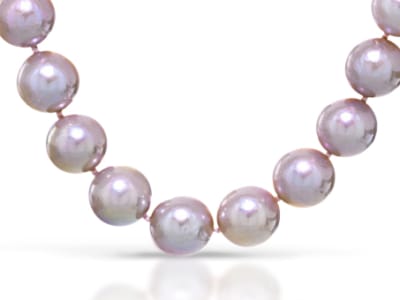Japan’s Lake Biwa once produced freshwater pearls were very popular among freshwater pearl lovers, but ongoing pollution issues led to their extinction in recent decades. To fill the void left in the market, Japanese pearl growers began culturing freshwater pearls in Lake Kasumigaura, located in northeastern Japan. Kasumigaura’s name translates to “the body of water beyond the mist” and the pearl farms are located in the upstream areas. Unfortunately, these pearls have also become increasingly scarce due to environmental issues. While there are reports that Kasumiga pearl production ceased in 2006-2007, production continues, on a very, very small scale. Kasumiga pearls are grown by using a bead-nucleated hybrid mussel and are known (and highly prized) for their large sizes and high luster. Good quality Kasumiga pearls rival the value and rarity of South Sea pearls. They are just as large and lustrous with a variety of colors ranging from white, cream, pink to purple. The size of the pearls can range from 9 – 13mm. Because of the ongoing environmental issues, finer quality Kasumiga pearls are extremely limited—and highly desirable to pearl lovers around the world. Because of their rarity, Kasumiga pearls can command premium prices for the finest qualities.
General Information
LWUV: Cream/light yellow: weak chalky green blue; Cream: blue; Pink/purple/golden Inert to very weak chalky green or bluish green; Orange: inert
Kasumiga Pearl Colors
-
 Blue
Blue -
 Brown
Brown -
 Gray
Gray -
 Orange
Orange -
 Pink
Pink -
 Purple
Purple -
 Yellow
Yellow
Alternate Names
Kasumi Pearls, Japanese Cultured Freshwater Pearl
Countries of Origin
Unknown; Japan
History
Lake Kasumigaura is Japan’s second largest lake. Pearl farming was first initiated at the lake in 1931 but it did not gain prominence until the 1980’s when pearl farming at Lake Biwa began to decline. The oysters that are used for pearl farming are hybrids of the Hyriopsis schlegelii and Hyriopsis cumingii oysters. All the pearls are bead nucleated and the growth period is between 3.5 to 4 years.
Care
Avoid cosmetics, perfumes, hairsprays, heat and household chemicals. Pink Kasumiga pearls will fade if exposed to heat.
